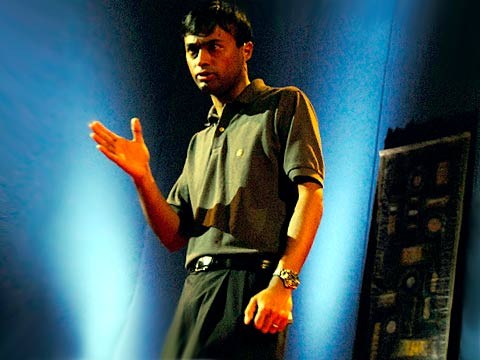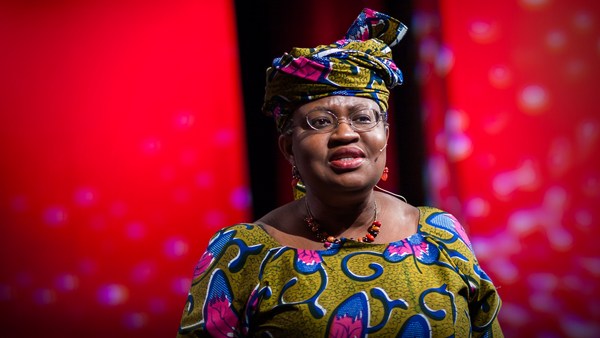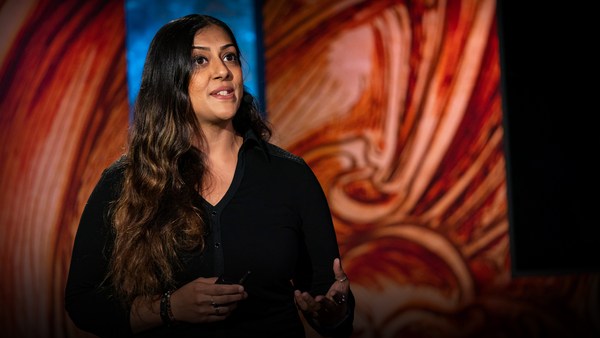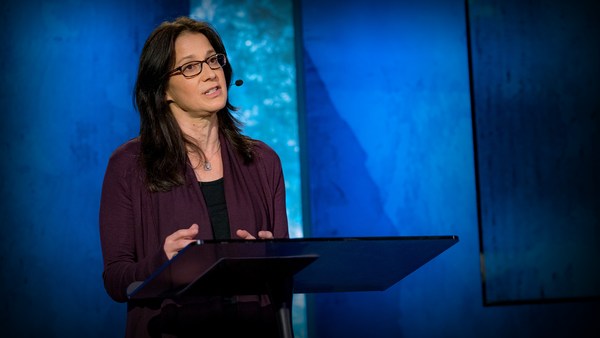I just want to start with a little bit of a word of warning, and that is: my job here tonight is to be a little bit of a "doctor bring-me-down." So bear with me for a few minutes, and know that after this, things will get lighter and brighter. So let's start.
I know that many of you have heard the traveler's adage, "Take nothing but pictures, leave nothing but footprints." Well, I'm going to say I don't think that's either as benign nor as simple as it sounds, particularly for those of us in industries who are portraying people in poor countries, in developing countries and portraying the poor. And those of us in those industries are reporters, researchers and people working for NGOs; I suspect there are a lot of us in those industries in the audience. We're going overseas and bringing back pictures like this: of the utterly distressed or the displaced or the hungry or the child laborers or the exotic.
Now, Susan Sontag reminds us that photographs, in part, help define what we have the right to observe, but more importantly, they are an ethics of seeing. And I think right now is a good time to review our ethics of seeing, as our industries of reporting and research and NGO work are collapsing and changing, in part, by what's being driven by what's happening in the economy. But it's making us forge new relationships. And those new relationships have some fuzzy boundaries. I worked at the edge of some of these fuzzy boundaries, and I want to share with you some of my observations.
My ethics of seeing is informed by 25 years as a reporter covering emerging economies and international relations. And I believe in a free and independent press. I believe that journalism is a public good. But it's getting harder to do that job, in part, because of the massive layoffs, because the budgets for international reporting aren't there anymore, new technologies and new platforms begging new content, and there are a lot of new journalisms. There's activist journalism, humanitarian journalism, peace journalism, and we are all looking to cover the important stories of our time. So we're going to NGOs and asking them if we can embed in their projects. This is in part because they're doing important work in interesting places.
That's one example here: this is a project I worked on in the Blue Nile in Ethiopia. NGOs understand the benefits of having reporters tag along on their team. They need the publicity, they are under tremendous pressure, they're competing in a very crowded market for compassion. So they're also looking to reporters and to hire freelance reporters to help them develop their public relations material and their media material. Now, researchers are also under pressure. They're under pressure to communicate their science outside of the academy. So they're collaborating with reporters, because for many researchers, it's difficult for them to write a simple story or a clear story. And the benefit for reporters is that covering field research is some of the best work out there. You not only get to cover science, but you get to meet interesting scientists, like my PhD advisor Revi Sterling, she, of the magic research high tops there. And it was a discussion with Revi that brought us to the edge of the researcher and reporter, that fuzzy boundary. And I said to her, "I was looking forward to going to developing countries and doing research and covering stories at the same time." She said, "I don't think so, girlfriend." And that confusion, that mutual confusion, drove us to publish a paper on the conflicting ethics and the contradictory practices of research and reporting. We started with the understanding that researchers and reporters are distant cousins, equally storytellers and social analysts. But we don't see nor portray developing communities the same way.
Here's a very classic example. This is Somalia, 1992. It could be Somalia today. And this is a standard operating procedure for much of the news video and the news pictures that you see, where a group of reporters will be trucked in, escorted to the site of a disaster, they'll produce their material, take their pictures, get their interviews, and then they'll be escorted out. This is decidedly not a research setting.
Now, sometimes, we're working on feature stories. This is an image I took of a woman in Bhongir Village in Andhra Pradesh in India. She's at a microfinance meeting. It's a terrific story. What's important here is that she is identifiable. You can see her face. This also is not a research picture. This is much more representative of a research picture. It's a research site: you see young women accessing new technologies. It's more of a time stamp, it's a documentation of research. I couldn't use this for news. It doesn't tell enough, and it wouldn't sell.
But then, the differences are even deeper than that. Revi and I analyzed some of the mandates that researchers are under. They are under some very strict rules governed by their university research review boards when it comes to content and confidentiality. Researchers are mandated to acquire document-informed consent. Well, as a reporter, if I hang a microphone on someone, that is consent. And when it comes to creating the story, I'll fact-check as a reporter, but I don't invite company to create that story, whereas social scientists, researchers, and particularly participatory researchers, will often work on constructing the narrative with the community. And when it comes to paying for information, "checkbook journalism" is roundly discouraged, in part, because of the bias it introduces in the kind of information you get. But social scientists understand that people's time is valuable so they pay them for that time.
So while journalists are well-placed to convey the beauty of the scientific process -- and I would add, the NGO process -- what about the warts? What happens if a research project is not particularly well-designed, or an NGO project doesn't fulfill its goals? Or the other kind of warts, you know, what happens after dark when the drinks happen. Research environments and reporting trips and NGO projects are very intimate environments; you make good friends while you're doing good work. But there's a little bit of Johnnie Walker journalism after dark, and what happens to that line between embedded and in-bedded? Or what do you do with the odd and odious behavior? The point is that you'll want to negotiate in advance what is on the record and off the record.
I'm going to turn now to some NGO imagery which will be familiar to some of you in this audience.
(Video) Narrator: For about 70 cents, you can buy a can of soda, regular or diet. In Ethiopia, for just 70 cents a day, you can feed a child like Jamal nourishing meals. For about 70 cents, you can also buy a cup of coffee. In Guatemala, for 70 cents a day, you can help a child like Vilma get the clothes she needs to attend school.
Leslie Dodson: Now, there's some very common imagery that's been around for 40 years. That's part of Sally Struthers's famine campaign. Some of it is very familiar; it's the Madonna and child. Women and children are very effective in terms of NGO campaigns. We've been looking at this imagery for a long time, for hundreds and hundreds of years; the Madonna and child. Here is [Duccio], and here is Michelangelo. My concern is: Are we one-noting the genders in our narratives of poverty in developing communities? Do we have women as victims, and are men only the perpetrators? Are they the guys with the AK-47s or the boy soldiers? Because that doesn't leave room for stories like the man who's selling ice cream at the refuge camp in Southern Sudan, where we did a project, or the stories of the men who are working on the bridge over the Blue Nile. So I wonder: Are these stories inconvenient to our narratives?
And what about this narrative? This is a for-profit game, and its aim is to make development fun. One question is: Did they inadvertently make fun of? Another set of questions is: What are the rights of these children? What rights of publicity or privacy do they have? Did they get paid? Should they get paid? Should they share in the profit? This is a for-profit game. Did they sign talent waivers? I have to use these when I'm working with NGOs and documentary filmmakers here in the States. In the States, we take our right to privacy and publicity very seriously. So what is it about getting on a long-haul flight that makes these rights vaporize?
I don't want to just pick on our friends in the gaming arts; I'll turn to the graphic arts, where we often see these monolithic, homogeneous stories about the great country of Africa. But Africa is not a country, it's a continent. It's 54 countries and thousands and thousands of languages. So my question is: Is this imagery productive, or is it reductive? I know that it's popular.
USAID just launched their campaign "Forward" -- FWD: Famine, War and Drought. And by looking at it, you would think that was happening all the time, all over Africa. But this is about what's happening in the Horn of Africa. And I'm still trying to make sense of Africa in a piece of Wonder Bread. I'm wondering about that.
Germaine Greer has wondered about the same things and she says, "At breakfast and at dinner, we can sharpen our own appetites with a plentiful dose of the pornography of war, genocide, destitution and disease." She's right. We have sharpened our appetites. But we can also sharpen our insights. It is not always war, insurrection and disease. This is a picture out of South Sudan, just a couple of months before the new country was born.
I will continue to work as a researcher and a reporter in developing countries, but I do it with an altered ethic of seeing. I ask myself whether my pictures are pandering, whether they contribute to stereotypes, whether the images match the message, am I complacent or am I complicit?
Thank you.
(Applause)





